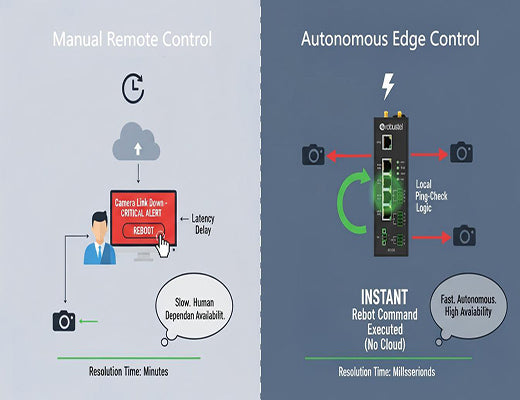
The Self-Healing Edge: How Autonomous PoE Control Eliminates Device Downtime
|
|
Time to read 4 min
|
|
Time to read 4 min
This guide explores a powerful, autonomous form of edge control: the self-healing network. We'll explain how an intelligent PoE router, like the Robustel R2120, can do more than just be remotely commanded; it can autonomously reboot a frozen downstream device. By using a built-in "watchdog" feature to monitor the health of a connected IP camera or other PoE device, this advanced edge control loop can automatically detect a failure and power cycle the device to restore operation, creating a truly resilient, self-healing system without any human intervention.
Self-healing edge control is the next level of reliability, where the edge device itself autonomously detects and resolves faults.
It solves the problem of "unknown downtime," where a remote device freezes, but no one is aware of the problem until it's too late.
The technology relies on a "PoE watchdog" feature, where the router constantly "pings" the connected device and will automatically power cycle its PoE port if it fails to respond.
This feature transforms the R2120 from a simple connectivity device into an active, 24/7 autonomous maintenance engineer for your critical assets.
I was talking with the IT director for a city's public transit system. They had cameras in hundreds of remote bus shelters. "Remote reboot via the cloud is great," he said, "but my biggest problem is the 'unknown unknowns.' A camera freezes at 3 a.m. on a Sunday. No one is watching the video feed, so no one knows it's down. We don't find out until a security incident happens, and we discover the footage is missing."
His problem highlights a critical limitation of human-in-the-loop management. You can't fix what you don't know is broken. What if the edge device itself could be the watcher? What if it could detect the problem and fix it, all on its own?
Let's be clear: it can. This is not just remote control; this is a proactive, autonomous form of edge control. This is the self-healing edge.

In a previous guide, we discussed how an operator could use RCMS to remotely power cycle a frozen camera. That is a powerful tool, but it is still a reactive process that requires a human to "sense" and "decide."
A self-healing architecture automates the entire loop at the edge.
The 'aha!' moment for any manager responsible for uptime is discovering the "Connection Manager" or "PoE Watchdog" feature in a professional industrial router like the Robustel R2120.
Here's how it's configured to create a self-healing edge controlloop:
Once you click "save," you have created an autonomous, 24/7 maintenance engineer that lives inside your router.

The ultimate goal of edge control is to build systems that are not just connected, but are intelligent, resilient, and autonomous. The ability for an edge device to monitor the health of its peripherals and take corrective action on its own is a profound leap forward. It moves your hardware from being a passive tool that you manage, to an active partner that manages itself. By deploying a router with self-healing capabilities like the R2120, you are building a new level of "five-nines" reliability into the very edge of your network.

A1: A watchdog timer (WDT) is a hardware or software mechanism that is used to detect and recover from system malfunctions. The system's main program must periodically "pet" or reset the watchdog timer. If, due to a hardware fault or software freeze, the program fails to "pet" the timer, the watchdog will "bark" and force a system reboot. The R2120's PoE watchdog extends this concept to the devices it powers.
A2: Yes. The entire process happens locally on the router and does not require any insecure open ports from the internet. The router is simply monitoring a local device on its own private LAN. The router itself should still be secured as part of a comprehensive edge control security framework.
A3: Yes. When an autonomous reboot event is triggered, a professional router like the R2120 will log the event and can be configured to send an alert to a cloud platform like RCMS. This ensures that while the action is autonomous, the human operator is still informed that a potential problem with the end-device was detected and resolved.